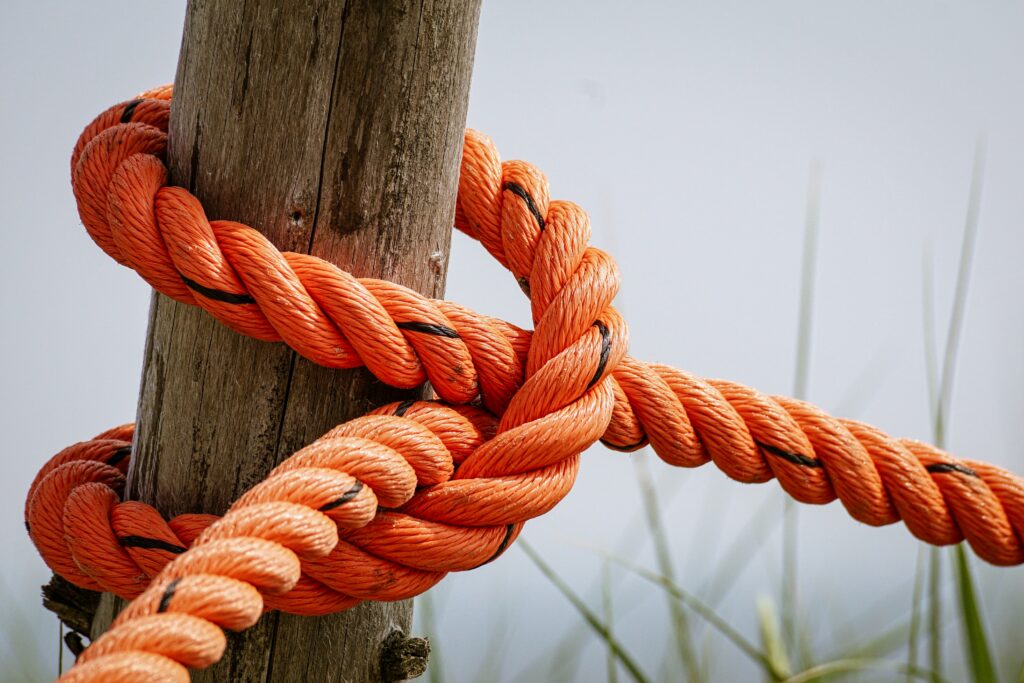- How Important is a Double Bowline Knot?
- How to Tie a Double Bowline Knot?
- Tips on Creating a Double Bowline Knot
- Knotting the Double Bowline Knot in Different Ways
- Top 5 Best Anchor Ropes For Knotting
- Attwood Solid Braid MFP Anchor Line
- Extreme Max 3006.2057
- Rainier Supply Co Double Braided Nylon Anchor Rope
- YOUNG MARINE Premium Solid Braid
- Attwood Hollow Braided Polypropylene
- Final Takeaway
The round-turn bowline is another name for the double bowline knot, often referred to as a water bowline. It’s essentially a bowline knot with two overhand loops or an additional wrapping turn around the bright. The double bowline’s enhanced strength and toughness make it ideal for strenuous activities and heavy-duty rigging.
How Important is a Double Bowline Knot?
For generations, anglers and sailors have employed the double bowline knot to secure sails to boats. It is believed to be the most important boat knot to master. It’s also a popular climber’s knot since it has a loop at the end that they may use to secure gear or even the climber to the rest of their gear. You can use the double bowline knot in a variety of situations. It’s mostly used to securely attach one item to another but retain the capacity to release quickly if relaxed.
Today we’re going to discuss how to tie the popular double bowline knot. The water bowline is sometimes compared to the double bowline knot because of some similarities, mostly in their ties. Let us see how the double bowline knot is different from the water bowline knot.
How to Tie a Double Bowline Knot?
Normally, with a water bowline knot, 2 1/2 ft. is needed to form a loop and then the pin of the rope is inserted. In that way, you can create a bowline knot.
With a double bowline knot, you need an extra length of rope. Unlike a water bowline knot that uses 2 1/2 ft. to create a loop, the double bowline knot use 3 ft. and more depending on how you manage to length your arms and where you are positioned in.
First, you need to create a loop using the 3 ft. length of the rope.
Then, come back to the loop to create another loop right on top of the first one you created. (You can make them a little bit smaller depending on the size of the loop or how far down you can go).
Second, if you have those two loops set and they’re on top of each other. Take your working end, go up through the two loops so that you can go around, come under the standing end of the rope, and back through the same loop.
Third, pull the loops and dress the knots you created with steps 1 and 2. Then that creates the double bowling knot, and it’s a little more secured than the regular water bowling knot because you get that extra loop.
Tips on Creating a Double Bowline Knot
Take the time you need to learn how to tie a proper knot. If possible, exert effort and time to search for more tutorials to make it perfect.
If you knot it too loosely, it may slip out of position. It is best to always double-check your knotting before leaving the rope because it may cause uncertain accidents if it happens.
It will fuse if it is tied wrongly and will not untie. Make sure to check the tie section or phase before advancing to the next step because it may cause you a headache if you leave it untied.
Before suspending a large object from it, cinch it down. It is better to check or make certain the loop is sturdy enough to hold heavy objects before taking it in action.
Try a different rope with varied textures and diameters if you’re having trouble tying the knot. Not all ropes are equal. So check for the best ropes for you and the one you are used to.
A smooth, slippery, tiny weighted rope may not produce the same outcomes as a shoelace used for practice. We all know that the length, grips, and overall features of a shoelace are far from the actual rope that is made and used for bowline knotting. So for better reference, search for more information about the ropes used for bowline knotting.
Knotting the Double Bowline Knot in Different Ways
The Spanish bowline is similar to the double bowline knot, except instead of one loop, it features two equal-length loops. Multiple objects can be attached to one endpoint by using two loops.
The double Yosemite bowline is the same knot as the Yosemite bowline but with an additional Yosemite finishing step. This knot can be done using the slip-knot method for even faster release.
Top 5 Best Anchor Ropes For Knotting
Attwood Solid Braid MFP Anchor Line
This strong braid anchor line has exceptional capabilities. Holding this rope will keep you still and at ease while your boat can be safely anchored anywhere. Your boat can be docked on rough water and stay in the same spot, and it may sway a little, but the water does not drag it. Because of the 100% multifilament polypropylene, it’s more than just a braided anchor rope if you look closely. This technique is believed to establish the required strength to hold all forms of anchors.
It measures 100 ft. in length, which is more than enough for the anchor to reach the seabed. The rope floats while also securing the boat. They will not recover the anchor in this scenario. The anchor will be easy to recover in this instance. They can also use it to anchor pontoons and other watercraft. The 3/8 inch girth fits perfectly in your palms, making docking, knotting, and anchoring the boat easier. It’s one of the more flexible anchor ropes available on the market.
Extreme Max 3006.2057
Black, Royal Blue, White, Burgundy, Forest Green, Neon Green, Neon Orange, Neon Yellow, Red, and Blue are among the colors available. There are also three lengths available: 50 feet, 100 feet, and 150 feet, all 3/8 inch diameter. And because it is versatile, there are numerous options. This 3/8 anchor rope is made of high-quality multifilament polypropylene.
The round, smooth, and flexible solid braid are the best. As a result, it won’t kink or hackle. When used as mooring lines, cutting it will not unravel. The special protection of the rope is made of marine-grade stainless steel, which means it won’t corrode or rust. The anchor can be connected with a snap hook. The working load limit is 250 pounds, whereas the breaking strength is 1290 pounds.
Rainier Supply Co Double Braided Nylon Anchor Rope
It’s ultra-soft, making it comfortable to anchor a boat while still gentle on the hull. Because it’s made of double braided nylon, it doesn’t bunch up like a three-strand line, making it more convenient to use and knot.
The tensile strength of this line is quite strong. Shock absorption has also been enhanced. It’s whipped from the throat to the very end by an expert. This is done to make it more durable.
YOUNG MARINE Premium Solid Braid
This is a solid premium solid braid MFP anchor line. Towing, hoisting, berthing, knotting, and, most critically, safe navigation is all functions it performs. It’s lovely how light it is while still being so strong. Expect it to exert a significant load force, with 1565 pounds as the breaking load.
This anchor line is made up of flexible fibers. Its suppleness and resistance to friction, sunshine, chemicals, mildew, dampness and tremendous stress are impressive. It even fulfills safety criteria, and it may be used for more than just anchoring, such as mooring and various combinations.
Attwood Hollow Braided Polypropylene
Everyone can use this rope for more than just boat anchoring. It can be attached to floaties, such as a throw ring or a life-saving ring, and it’s a measure of how dependable its strength is. It’s also possible to discover it in some pools. You can even use it to lift a person. This anchor line is strong, so you don’t have to be concerned about it snapping at any time. Its high-quality materials are credited.
It’s been wrapped around the boat anchor and is holding up well. It’s simple to do because it doesn’t tangle. The full length of polypropylene is rot-proof and abrasion-resistant. With continued use, it remains robust and functional for years.
Final Takeaway
One of the most fundamental skills that everyone should master is tying a knot. It assists us in various ways, but it can also save lives in an emergency. Knowing how to tie various knots offers numerous advantages, and you don’t have to be a survivalist. We can use almost any sort of knot in our daily lives. It would be best if you learned the double bowline knot, but you can also experiment on your own to find a knot that is equally reliable and simple to tie.







